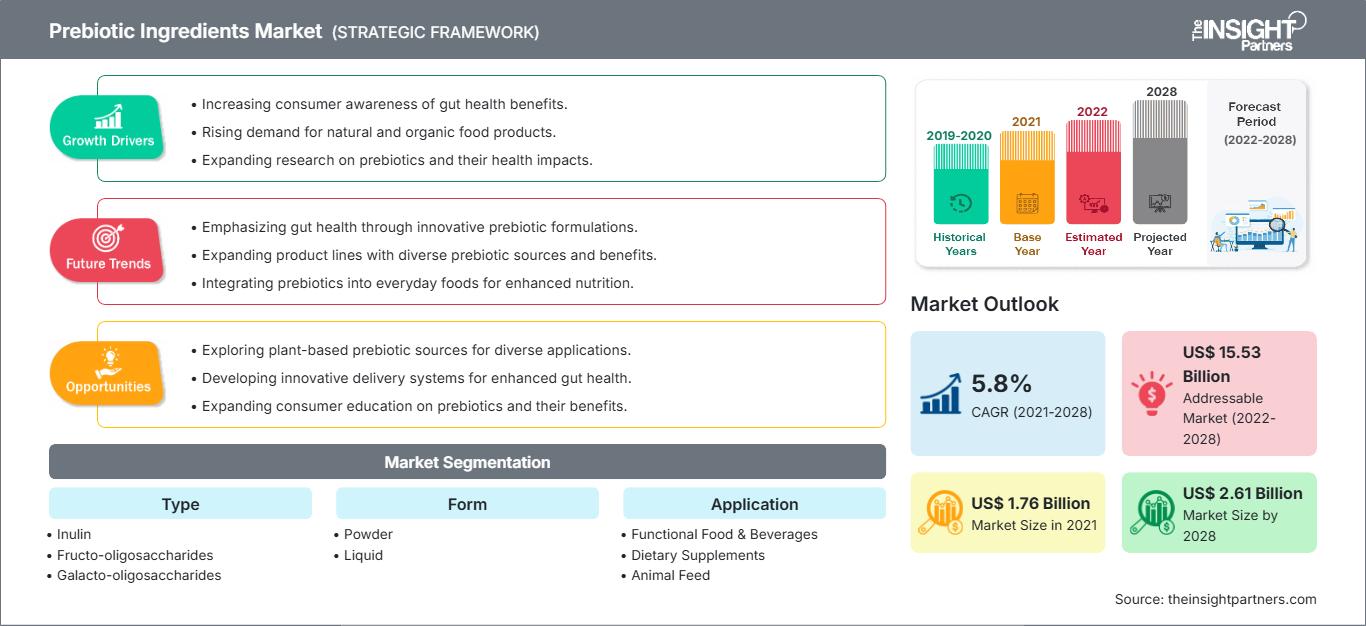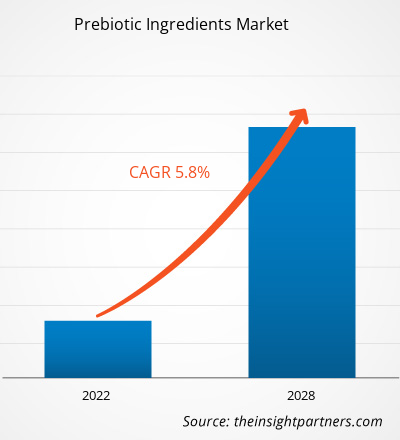[Rapport de recherche] Le marché des ingrédients prébiotiques devrait passer de 1 758,40 millions de dollars américains en 2021 à 2 607,72 millions de dollars américains d'ici 2028 ; il devrait croître à un TCAC de 5,8 % de 2022 à 2028.
Les prébiotiques sont des composés alimentaires qui induisent la croissance ou l'activité de micro-organismes bénéfiques tels que les bactéries et les champignons. La fermentation est le principal mécanisme d'action par lequel les bactéries bénéfiques utilisent les prébiotiques dans le côlon. Les prébiotiques jouent un rôle important dans les soins de santé préventifs, car la popularité croissante des compléments nutraceutiques riches en fibres chez les sportifs et les athlètes pour développer leur endurance et leur résistance stimule encore la demande d'ingrédients prébiotiques. Ainsi, la sensibilisation croissante aux soins de santé préventifs stimule la croissance du marché des ingrédients prébiotiques.
L'Asie-Pacifique détenait la plus grande part de marché des ingrédients prébiotiques en 2021, tandis que d'autres régions en développement, comme le Moyen-Orient et l'Afrique, détenaient la plus grande part de marché des ingrédients prébiotiques en 2021. L'Afrique devrait connaître une croissance significative au cours de la période de prévision. Cette croissance du marché est attribuée à l'augmentation des troubles intestinaux et immunitaires, ainsi qu'à la progression des maladies digestives. Les pays asiatiques sont enclins à adopter des aliments et des boissons sains et nutritifs pour améliorer la santé intestinale. Par conséquent, cette tendance à adopter une alimentation saine stimule la croissance du marché des ingrédients prébiotiques.
Vous bénéficierez d’une personnalisation sur n’importe quel rapport - gratuitement - y compris des parties de ce rapport, ou une analyse au niveau du pays, un pack de données Excel, ainsi que de profiter d’offres exceptionnelles et de réductions pour les start-ups et les universités
Marché des ingrédients prébiotiques: Perspectives stratégiques

- Obtenez les principales tendances clés du marché de ce rapport.Cet échantillon GRATUIT comprendra une analyse de données, allant des tendances du marché aux estimations et prévisions.
Impact de la pandémie de COVID-19 sur le marché des ingrédients prébiotiques
La pandémie de COVID-19 a posé des défis sans précédent à de nombreux secteurs au début de l'année 2020. Les confinements, les restrictions aux frontières, les interdictions de voyager, l'arrêt de la fabrication et d'autres mesures de sécurité mises en place par les gouvernements conformément aux directives de l'OMS et des ministères nationaux de la Santé ont entravé les opérations de fabrication. Cependant, l'épidémie de COVID-19 a eu un impact positif sur le marché, car les consommateurs recherchaient de plus en plus des alternatives naturelles et plus sûres pour rester en bonne santé et renforcer leur système immunitaire. La demande de compléments alimentaires a augmenté de façon spectaculaire au cours des premiers mois de la pandémie de COVID-19. De plus, comme les gens sont restés chez eux en raison des mandats gouvernementaux, ils se sont concentrés sur leur santé et leur forme physique, ce qui a stimulé la demande de prébiotiques pendant la pandémie de COVID-19.
Aperçu du marché
Demande croissante d'ingrédients prébiotiques dans l'alimentation et Secteur des boissons
La popularité des prébiotiques augmente dans l'industrie agroalimentaire grâce à leur utilisation dans les barres nutritionnelles, les produits laitiers, les boissons diététiques, les compléments minéraux, les céréales pour petit-déjeuner, les produits de boulangerie, les confiseries, les aliments verts et les préparations pour nourrissons. En novembre 2018, Kellogg's a lancé une nouvelle céréale, sous la marque HI! Happy Inside, contenant des prébiotiques et des probiotiques, dans le cadre de sa gamme de produits digestifs stimulants pour le transit intestinal. De plus, l'inuline est largement utilisée dans la transformation des aliments, car elle constitue un substitut sain et efficace aux matières grasses et au sucre. Les principaux pays producteurs de lait comme les États-Unis, l'Inde et la Chine utilisent des prébiotiques pour donner la texture souhaitée aux produits finis et fabriquer des produits laitiers sans sucre. De plus, les préparations pour nourrissons ou les aliments pour bébés contiennent divers ingrédients prébiotiques, notamment des galacto-oligosaccharides, des fructo-oligosaccharides et du polydextrose. Voici les facteurs qui stimulent la croissance du marché des ingrédients prébiotiques.
Informations par type
Selon le type, le marché des ingrédients prébiotiques est segmenté en inuline, fructo-oligosaccharides (FOS), galacto-oligosaccharides (GOS), mannan-oligosaccharides (MOS), entre autres. Le segment de l'inuline devrait enregistrer la plus grande part au cours de la période de prévision. Les fabricants l'utilisent dans les aliments et boissons transformés, les compléments alimentaires et les aliments pour animaux pour remplacer le sucre, les matières grasses et la farine. Aux États-Unis, en 2018, la Food and Drug Administration a approuvé l'inuline comme ingrédient de fibres alimentaires pour améliorer la valeur nutritionnelle des produits alimentaires manufacturés. De plus, la demande croissante de produits naturels accroît la demande mondiale d'inuline prébiotique. La croissance du segment de l'inuline est stimulée par l'augmentation des applications dans divers secteurs, ce qui alimente la croissance du marché des ingrédients prébiotiques.
Informations basées sur la forme
Selon la forme, le marché des ingrédients prébiotiques est segmenté en poudre et liquide. Le segment de la poudre devrait enregistrer un TCAC plus élevé sur le marché au cours de la période de prévision. La forme en poudre facilite la distribution et l'utilisation des prébiotiques. L'utilisation de la poudre prébiotique pour l'élevage gagne en popularité, car les prébiotiques en poudre sont accessibles à la consommation à tout stade de la vie du bétail. De plus, la productivité croissante des viandes, des œufs et du lait accroît la demande de prébiotiques en poudre.
Informations basées sur l'application
Selon l'application, le marché des ingrédients prébiotiques est segmenté en aliments et boissons fonctionnels, compléments alimentaires, aliments pour animaux, etc. Le segment des compléments alimentaires devrait enregistrer le TCAC le plus élevé du marché au cours de la période de prévision. La demande croissante de médicaments préventifs, le nombre croissant de troubles digestifs chez les personnes âgées et l'absence d'une alimentation équilibrée devraient accroître la demande de compléments alimentaires. Face à l'adoption croissante de régimes alimentaires malsains, les consommateurs privilégient de plus en plus les compléments alimentaires à base de prébiotiques.
Les principaux acteurs du marché des ingrédients prébiotiques sont BENEO GmbH ; COSUCRA ; DuPont Nutrition & Biosciences ; Clasado Ltd. ; Nexira ; Ingredion Incorporated ; SOLACTIS ; Cargill, Incorporated ; Sensus ; et Roquette Frères. Ces acteurs développent des produits à risques réduits pour la santé afin de répondre aux nouvelles tendances de consommation et de respecter les cadres réglementaires. Ils participent à des fusions et acquisitions, à des expansions d'activités et à des partenariats pour accroître leur part de marché.
Aperçu régional du marché des ingrédients prébiotiques
Les tendances régionales et les facteurs influençant le marché des ingrédients prébiotiques tout au long de la période de prévision ont été analysés en détail par les analystes de The Insight Partners. Cette section aborde également les segments et la géographie du marché des ingrédients prébiotiques en Amérique du Nord, en Europe, en Asie-Pacifique, au Moyen-Orient et en Afrique, ainsi qu'en Amérique du Sud et en Amérique centrale.
Portée du rapport sur le marché des ingrédients prébiotiques
| Attribut de rapport | Détails |
|---|---|
| Taille du marché en 2021 | US$ 1.76 Billion |
| Taille du marché par 2028 | US$ 2.61 Billion |
| TCAC mondial (2021 - 2028) | 5.8% |
| Données historiques | 2019-2020 |
| Période de prévision | 2022-2028 |
| Segments couverts |
By Type
|
| Régions et pays couverts | Amérique du Nord
|
| Leaders du marché et profils d'entreprises clés |
|
Densité des acteurs du marché des ingrédients prébiotiques : comprendre son impact sur la dynamique commerciale
Le marché des ingrédients prébiotiques connaît une croissance rapide, porté par une demande croissante des utilisateurs finaux, due à des facteurs tels que l'évolution des préférences des consommateurs, les avancées technologiques et une meilleure connaissance des bienfaits du produit. Face à cette demande croissante, les entreprises élargissent leur offre, innovent pour répondre aux besoins des consommateurs et capitalisent sur les nouvelles tendances, ce qui alimente la croissance du marché.

- Obtenez le Marché des ingrédients prébiotiques Aperçu des principaux acteurs clés
- Analyse historique (2 ans), année de base, prévision (7 ans) avec TCAC
- Analyse PEST et SWOT
- Taille du marché Valeur / Volume - Mondial, Régional, Pays
- Industrie et paysage concurrentiel
- Ensemble de données Excel
Rapports récents
Rapports connexes
Témoignages
Raison d'acheter
- Prise de décision éclairée
- Compréhension de la dynamique du marché
- Analyse concurrentielle
- Connaissances clients
- Prévisions de marché
- Atténuation des risques
- Planification stratégique
- Justification des investissements
- Identification des marchés émergents
- Amélioration des stratégies marketing
- Amélioration de l'efficacité opérationnelle
- Alignement sur les tendances réglementaires






















 Obtenez un échantillon gratuit pour - Marché des ingrédients prébiotiques
Obtenez un échantillon gratuit pour - Marché des ingrédients prébiotiques